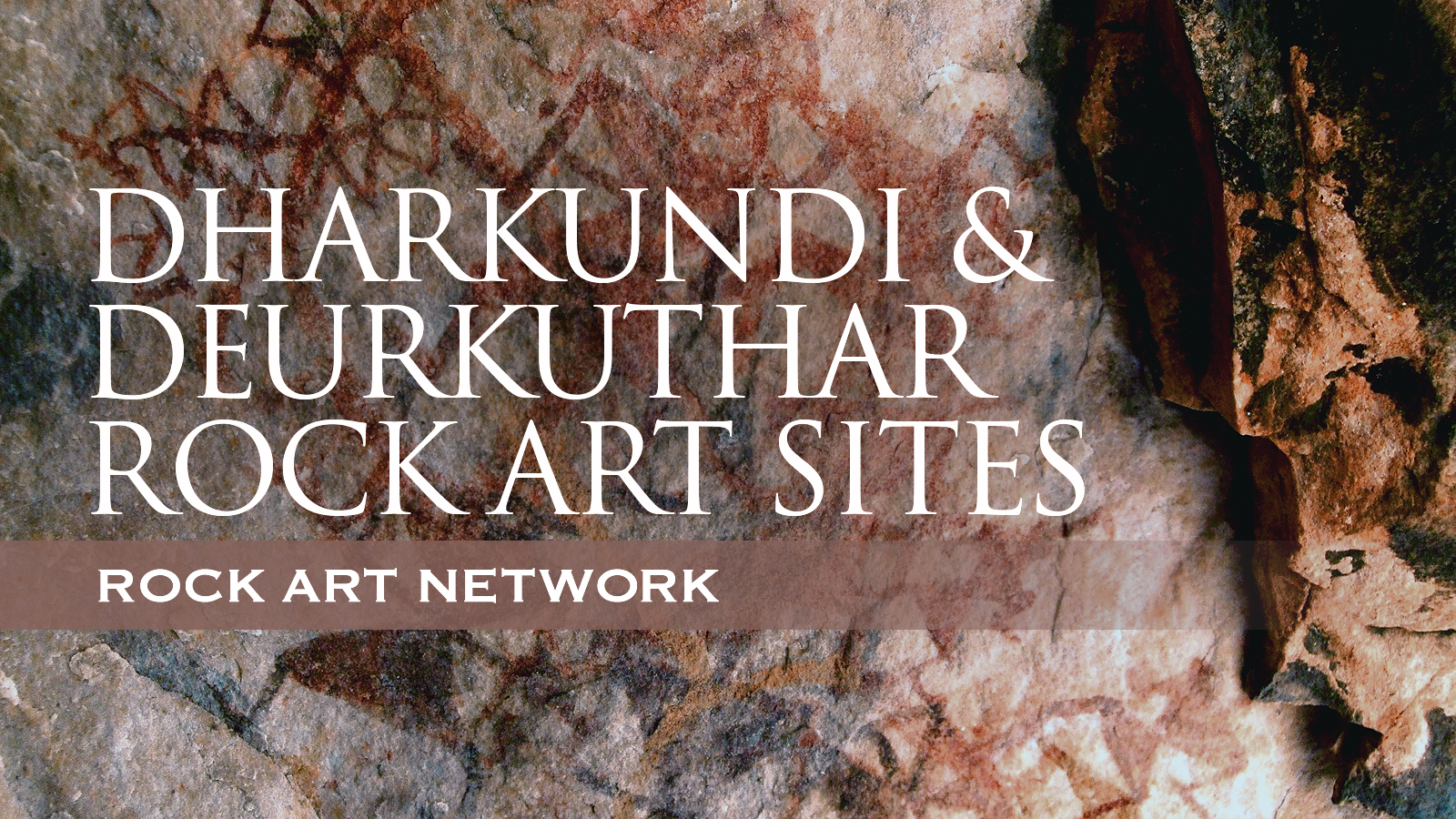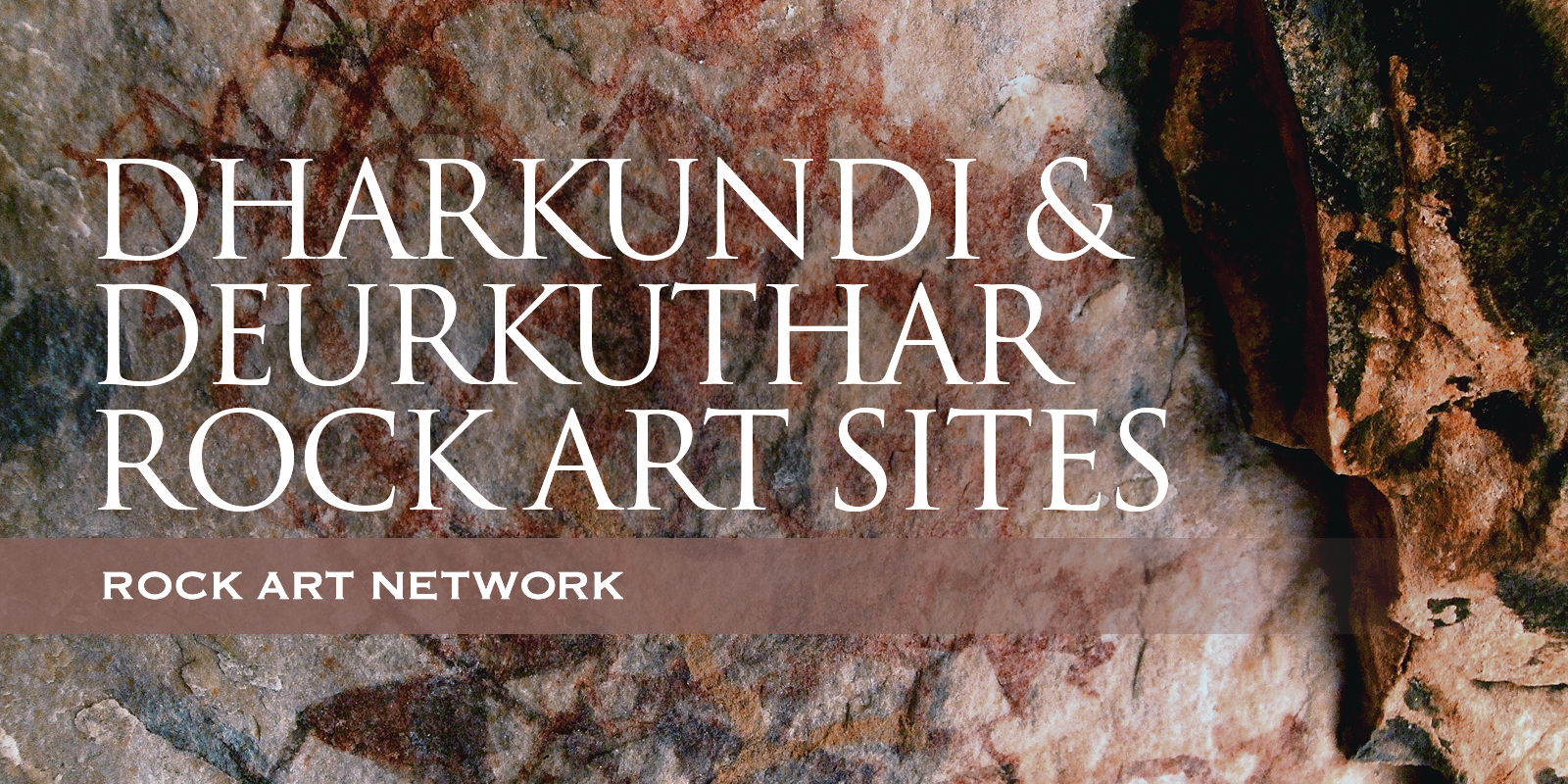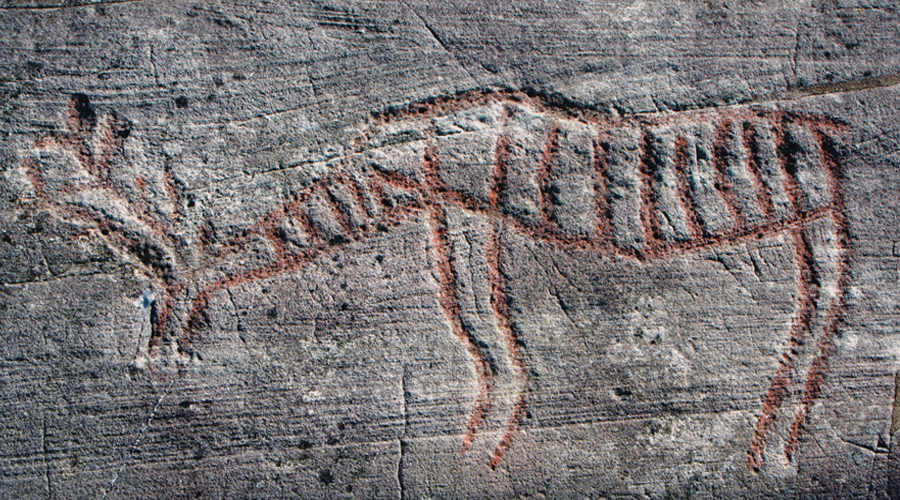


by Meenakshi Dubey-Pathak
Wakankar Senior Research Fellow
So far, this region was not known for its rock art sites, perhaps because the area is far from safe and one is not allowed to remain in it overnight. I had the opportunity to visit it and make enquiries on the occasion of our visit to a temple with an Ashram, i.e. a hermitage for Hindu sadhus or holy men. That temple (Fig. 1) had been built in a big open shelter with a large overhang, next to a waterfall and a pool. If there had once been any rock art there, which is quite probable due to its location and the size of the shelter, it was not preserved.
The name of Dharkundi comes from “dhara” (stream) and “kund”, a big hole into which the river flows. The Dharkundi area (24°47′42″N 81°9′8″E) is situated in the Satna district, one of the three districts of the Rewa division, 70km northeast of Rewa, at the border of Madhya Pradesh and Uttar Pradesh. In Madhya Pradesh the height of those hills varies from 1700 to 2250 feet above sea level. Their sandstone formations harbour hundreds of rock shelters, sometimes with extensive overhangs. The landscape mainly consists of jungles with abundant wild life including leopard, bear, wild boar, deer, antelope etc. Those jungles were (and still are now) populated in remote villages by various tribes such as the Kol, Baiga, Gond and Kori. They used to be hunter-gatherers but for hundreds of years they have been cultivators.
On questioning the head Sadhu about any rock art in the vicinity, he said that he and his companions knew of a few sites and they had been wondering about their purpose. They also told me that out of curiosity about the colours they had tried to rub and wash the paintings with coconut bark and water, but to their surprise the colours had remained intact! After telling them about the history, importance and value of rock art, they agreed to show me some of those rock art sites. We saw four of them, situated in a dense forest within 3 to 5kms of the Ashram, under the leadership of a younger sadhu called Baba Ramakant. He told us that the shelters’ names were Jogini Ki Gupha (gupha meaning cave and jogini meaning holy woman): Cave of the Holy Woman. To distinguish one site from the other, I called them 1, 2 (with 2a and 2b), 3 and 4. Thick banyan roots covered extensive surfaces of the walls in almost each shelter.
Early images of animals were made with dark red (Fig. 2). The work was sophisticated with a variety of intricate patterns. On the contrary, in the later period, the same kinds of animals were depicted in bright red, in a crude way, with thick lines and poor intricate designs (Fig. 3), sometimes incomplete.
Early images were superimposed (Fig. 4) with Buddhist auspicious symbols of lotus in different styles, such as twirling lotus (Fig. 5), conical lotus buds and simple flower pot (Fig. 6) in a three-tiered pedestal. Depiction of Dharmchakra (wheel of life) toran (decoration of the door), Kalash (a pitcher or pot with a large base and a small mouth, filled with water and topped with a cornet of mango leaves and a coconut), Chouk (a square-shaped decorated motif) in the rock art sites indicate the frequent visits of Buddhist monks in the Dharkundi area: they probably used those sites for meditation.
Being located centrally amongst famous Buddhist places like Sanchi, Koushambi, Sarnath, Bharhut and Deurkuthar, Derukuthar stupas and rock art sites are hardly 120kms from the Dharkundi area. Images of the Buddhist period are similar in both areas.
Deurkuthar is a well-known Buddhist place with stupas. Several painted sandstone shelters are nearby (Fig. 7). They are not well preserved, all the more as local villagers keep paying them visits for ceremonies, particularly on full moon nights, and leave traces of their rituals, such as red and white crude figures (Fig. 8), dots, finger marks and handprints (Fig. 9). The most important site is 10 to 12m long with a 5 to 6m overhang and it is 2 to 3.50 meters high. All the forepart of the overhang is eroded as well as the two extremities of the shelter. The spectacular art only consists of Buddhist symbols and lotus flowers in red, yellow and green (Fig. 10). Buddhism in rock art shows the use of those painted shelters by Buddhist monks.
The Mayura King Ashoka could have established the Deurkuthar stupas about 300 BC. Excavation of Deurkuthar, which seems to predate the late Mauryan-Sunga period (4th through 1st centuries BC), when most early stupas complexes were built, promises to throw light on the genesis and spread of Buddhism in Central India.
Surprisingly, no war or household scenes have been noticed at Dharkundi. It is strange as other rock art sites in central India, such as Bhimbetka, Pachmarhi, Adamgarh, Raisen area and Gandhisagar sites have many battle and household scenes from the Historic period.
Later period or recent handprints evidence ceremonial uses of the rock art sites in recent times and testify to the continuation of beliefs and traditions.
→ Members and affiliated institutions of the Rock Art Network
by
George Nash
5/09/2024 Recent Articles
→ Sigubudu: Paintings of people with guns in the northern uKhahlamba-Drakensberg
by Aron Mazel
22/07/2024
by Richard Kuba
13/06/2024
by Meenakshi Dubey-Pathak
8/03/2024
by Rock Art Network
6/02/2024
by Rock Art Network
14/12/2023
by Sam Challis
5/12/2023
by Aron Mazel
30/11/2023
by Sam Challis
21/11/2023
by Sam Challis
15/11/2023
by Sam Challis
10/11/2023
by Rock Art Network
6/11/2023
by Rock Art Network
3/11/2023
by Aron Mazel
2/11/2023
by Meenakshi Dubey-Pathak
26/09/2023
by Paul Taçon
24/08/2023
by Aron Mazel
13/06/2023
by Paul Taçon
5/06/2023
by Paul Taçon
15/03/2023
by George Nash
14/03/2023
by Noel Hidalgo Tan
10/02/2023
by George Nash
01/02/2023
by Meenakshi Dubey-Pathak, Pilar Fatás Monforte
29/11/2022
by Aron Mazel, George Nash
21/09/2022
by Paul S.C. Taçon, Sally K. May, Ursula K. Frederick, Jo McDonald
07/07/2022
by Meenakshi Dubey-Pathak
26/07/2022
by Paul Taçon
20/07/2022
by David Coulson
16 June 2022
by Paul Taçon
25 April 2022
by Noel Hidalgo Tan
20 April 2022
by Meenakshi Dubey-Pathak
14 March 2022
by Carolyn Boyd & Pilar Fatás
02 March 2022
by David Coulson
07 February 2022
by Johannes H. N. Loubser
06 February 2022
by Meenakshi Dubey-Pathak
05 February 2022
by Aron Mazel
28 January 2022
by Aron Mazel
8 September 2021
by David Coulson
17 August 2021
by Ffion Reynolds
21 June 2021


by Aron Mazel
22/07/2024
by Richard Kuba
13/06/2024
by Meenakshi Dubey-Pathak
8/03/2024
by Rock Art Network
6/02/2024
by Rock Art Network
14/12/2023
by Sam Challis
5/12/2023
by Aron Mazel
30/11/2023
by Sam Challis
21/11/2023
by Sam Challis
15/11/2023
by Sam Challis
10/11/2023
by Rock Art Network
6/11/2023
by Rock Art Network
3/11/2023
by Aron Mazel
2/11/2023
by Meenakshi Dubey-Pathak
26/09/2023
by Paul Taçon
24/08/2023
by Aron Mazel
13/06/2023
by Paul Taçon
5/06/2023
by Paul Taçon
15/03/2023
by George Nash
14/03/2023
by Noel Hidalgo Tan
10/02/2023
by George Nash
01/02/2023
by Meenakshi Dubey-Pathak, Pilar Fatás Monforte
29/11/2022
by Aron Mazel, George Nash
21/09/2022
by Paul S.C. Taçon, Sally K. May, Ursula K. Frederick, Jo McDonald
07/07/2022
by Meenakshi Dubey-Pathak
26/07/2022
by Paul Taçon
20/07/2022
by David Coulson
16 June 2022
by Paul Taçon
25 April 2022
by Noel Hidalgo Tan
20 April 2022
by Meenakshi Dubey-Pathak
14 March 2022
by Carolyn Boyd & Pilar Fatás
02 March 2022
by David Coulson
07 February 2022
by Johannes H. N. Loubser
06 February 2022
by Meenakshi Dubey-Pathak
05 February 2022
by Aron Mazel
28 January 2022
by Aron Mazel
8 September 2021
by David Coulson
17 August 2021
by Ffion Reynolds
21 June 2021
Friend of the Foundation


by Aron Mazel
22/07/2024
by Richard Kuba
13/06/2024
by Meenakshi Dubey-Pathak
8/03/2024
by Rock Art Network
6/02/2024
by Rock Art Network
14/12/2023
by Sam Challis
5/12/2023
by Aron Mazel
30/11/2023
by Sam Challis
21/11/2023
by Sam Challis
15/11/2023
by Sam Challis
10/11/2023
by Rock Art Network
6/11/2023
by Rock Art Network
3/11/2023
by Aron Mazel
2/11/2023
by Meenakshi Dubey-Pathak
26/09/2023
by Paul Taçon
24/08/2023
by Aron Mazel
13/06/2023
by Paul Taçon
5/06/2023
by Paul Taçon
15/03/2023
by George Nash
14/03/2023
by Noel Hidalgo Tan
10/02/2023
by George Nash
01/02/2023
by Meenakshi Dubey-Pathak, Pilar Fatás Monforte
29/11/2022
by Aron Mazel, George Nash
21/09/2022
by Paul S.C. Taçon, Sally K. May, Ursula K. Frederick, Jo McDonald
07/07/2022
by Meenakshi Dubey-Pathak
26/07/2022
by Paul Taçon
20/07/2022
by David Coulson
16 June 2022
by Paul Taçon
25 April 2022
by Noel Hidalgo Tan
20 April 2022
by Meenakshi Dubey-Pathak
14 March 2022
by Carolyn Boyd & Pilar Fatás
02 March 2022
by David Coulson
07 February 2022
by Johannes H. N. Loubser
06 February 2022
by Meenakshi Dubey-Pathak
05 February 2022
by Aron Mazel
28 January 2022
by Aron Mazel
8 September 2021
by David Coulson
17 August 2021
by Ffion Reynolds
21 June 2021
Friend of the Foundation

























